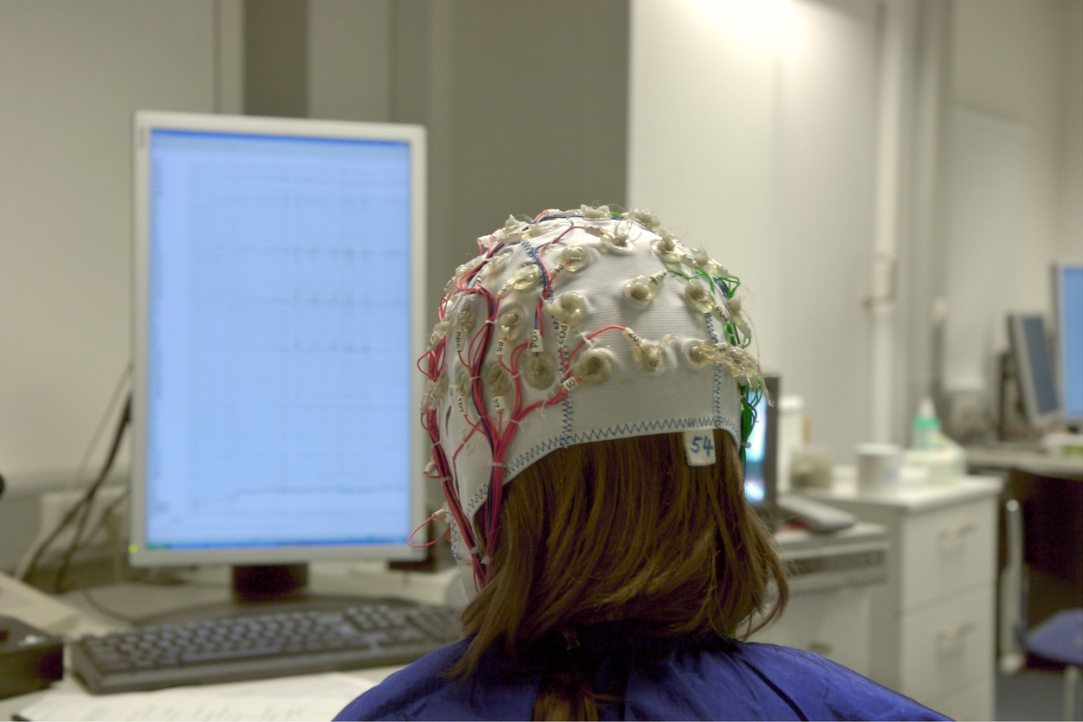Electrical Brain Stimulation Helps Memorise New Words

A team of researchers at HSE University, in collaboration with scientists from Russian and foreign universities, has investigated the impact of electrical brain stimulation on learning new words. The experiment shows that direct current stimulation of language centres—Broca's and Wernicke's areas—can improve and speed up the memorisation of new words. The findings have been published in Neurobiology of Learning and Memory.
The transcranial direct current stimulation (tDCS) technique involves applying a low direct current to specific areas of the brain. The advantages of tDCS include its simplicity, affordability, and non-invasive nature, meaning it does not require surgical intervention or expensive equipment. All that is required is the correct placement of electrodes on the head.
Researchers from HSE University, the N.P. Bekhtereva Institute of the Human Brain of the Russian Academy of Sciences, Sirius University, and the Gestalt Centre London, in collaboration with St Petersburg State University, investigated how transcranial direct current stimulation of Broca's and Wernicke's areas affects new word acquisition. These two areas are the brain's primary language centres, typically located in the left hemisphere for most people. The authors of the study conducted a large-scale, complex experiment involving 160 participants.

'We developed a rather complex experimental design, aiming to account for as many factors influencing learning as possible to obtain the most comprehensive picture of the process of acquiring new words. We aimed to determine whether transcranial direct current stimulation actually aids in memorising new words, whether a specific stimulation mode influences memorisation, and which brain area—Broca's or Wernicke's—plays a more significant role in the process of learning new words,' explains Olga Sherbakova, Leading Research Fellow at the Cognitive Health and Intelligence Centre of the HSE Institute for Cognitive Neuroscience.
To account for all these factors, participants were randomly assigned to five groups, subjected, respectively, to anodal stimulation of Broca’s area, anodal stimulation of Wernicke’s area, cathodal stimulation of Broca’s area, cathodal stimulation of Wernicke’s area, and placebo stimulation as a control, with inactive electrodes placed on the scalp.
The stimulation lasted 15 minutes, after which participants were instructed to memorise 16 new words—or more precisely, pseudowords—designed specifically for the experiment using the phonetic and rhythmic structure of the Russian language.
'People use two strategies to learn new words: explicit learning, where we are shown an object and told, "this is a table," and implicit learning, where we infer the meaning of a word from its context. In our experiment, we aimed to determine which memorisation strategy would be more effective under stimulation,' Shcherbakova explains. 'Additionally, we asked the participants to repeat some words aloud to investigate whether, as is commonly believed, articulation—pronouncing memorised words aloud—actually aids in memorisation.'
During the experiment, participants were shown images of unfamiliar objects, such as ancient musical instruments or rare deep-sea fish. While viewing each image, participants either heard a new word, such as 'This is SEN' (explicit strategy), or a question, such as 'Is SEN furry?' (implicit strategy).
After the learning phase, each group was assessed to determine which of them learned the new words most effectively and whether the learning strategy had any impact on the outcome. Participants first had to recognise a word by ear and then associate it with the image. The outcome assessment considered both the speed and accuracy of the response.
The results of the experiment show that both the explicit and implicit strategies lead to similarly successful word acquisition but engage different neural mechanisms, as evidenced by the varying effects of the different stimulation modes. It was also found that articulation contributes to better memorisation: participants recognised the words they had said aloud during the learning phase more accurately and quickly.
Most importantly, the study authors demonstrated that transcranial direct current stimulation significantly improves word memorisation, with the greatest effect resulting from anodal stimulation of Broca's area and cathodal stimulation of Wernicke's area. It is also important to note that the study found no adverse effects of tDCS on the outcomes of word learning in any of the groups.

This is the first tDCS study to consider such a wide range of factors potentially affecting language learning and to yield reliable results. 'We were able not only to demonstrate that tDCS has a positive effect on language learning, but also to identify the optimal stimulation modes for such learning,' Sherbakova emphasises.
In the future, the researchers plan to investigate the delayed effects of tDCS and determine how long its positive impact on the brain's language areas lasts. Potentially, transcranial direct current stimulation could be used to restore language abilities in patients after a stroke, brain injury, or neurodegenerative disease, as well as to enhance the cognitive abilities of healthy individuals.
See also:
Scientists Have Modelled Supercapacitor Operation at Molecular and Ionic Level
HSE scientists used supercomputer simulations to study the behaviour of ions and water molecules inside the nanopores of a supercapacitor. The results showed that even a very small amount of water alters the charge distribution inside the nanopores and influences the device’s energy storage capacity. This approach makes it possible to predict how supercapacitors behave under different electrolyte compositions and humidity conditions. The paper has been published in Electrochimica Acta. The study was supported by a grant from the Russian Science Foundation (RSF).
Designing an Accurate Reading Skills Test: Why Parallel Texts are Important in Dyslexia Diagnosis
Researchers from the HSE Centre for Language and Brain have developed a tool for accurately assessing reading skills in adults with reading impairments. It can be used, for instance, before and after sessions with a language therapist. The tool includes two texts that differ in content but are equal in complexity: participants were observed to read them at the same speed, make a similar number of errors, and understand the content to the same degree. Such parallel texts will enable more accurate diagnosis of dyslexia and better monitoring of the effectiveness of interventions aimed at addressing it. The paper has been published in Educational Studies.
Internal Clock: How Heart Rate and Emotions Shape Our Perception of Time
Our perception of time depends on heart rate—this is the conclusion reached by neuroscientists at HSE University. In their experiment, volunteers watched short videos designed to evoke specific emotions and estimated each video's duration, while researchers recorded their heart activity using ECG. The study found that the slower a participant's heart rate, the shorter they perceived the video to be—especially when watching unpleasant content. The study has been published in Frontiers in Psychology.
Scientists Identify Personality Traits That Help Schoolchildren Succeed Academically
Economists from HSE University and the Southern Federal University have found that personality traits such as conscientiousness and open-mindedness help schoolchildren improve their academic performance. The study, conducted across seven countries, was the first large-scale international analysis of the impact of character traits on the academic achievement of 10 and 15-year-olds. The findings have been published in the International Journal of Educational Research.
HSE Scientists Reveal How Disrupted Brain Connectivity Affects Cognitive and Social Behaviour in Children with Autism
An international team of scientists, including researchers from the HSE Centre for Language and Brain, has for the first time studied the connectivity between the brain's sensorimotor and cognitive control networks in children with autism. Using fMRI data, the researchers found that connections within the cognitive control network (responsible for attention and inhibitory control) are weakened, while connections between this network and the sensorimotor network (responsible for movement and sensory processing) are, by contrast, excessively strong. These features manifest as difficulties in social interaction and behavioural regulation in children. The study has been published in Brain Imaging and Behavior.
Similar Comprehension, Different Reading: How Native Language Affects Reading in English as a Second Language
Researchers from the MECO international project, including experts from the HSE Centre for Language and Brain, have developed a tool for analysing data on English text reading by native speakers of more than 19 languages. In a large-scale experiment involving over 1,200 people, researchers recorded participants’ eye movements as they silently read the same English texts and then assessed their level of comprehension. The results showed that even when comprehension levels were the same, the reading process—such as gaze fixations, rereading, and word skipping—varied depending on the reader's native language and their English proficiency. The study has been published in Studies in Second Language Acquisition.
Mortgage and Demography: HSE Scientists Reveal How Mortgage Debt Shapes Family Priorities
Having a mortgage increases the likelihood that a Russian family will plan to have a child within the next three years by 39 percentage points. This is the conclusion of a study by Prof. Elena Vakulenko and doctoral student Rufina Evgrafova from the HSE Faculty of Economic Sciences. The authors emphasise that this effect is most pronounced among women, people under 36, and those without children. The study findings have been published in Voprosy Ekonomiki.
Scientists Discover How Correlated Disorder Boosts Superconductivity
Superconductivity is a unique state of matter in which electric current flows without any energy loss. In materials with defects, it typically emerges at very low temperatures and develops in several stages. An international team of scientists, including physicists from HSE MIEM, has demonstrated that when defects within a material are arranged in a specific pattern rather than randomly, superconductivity can occur at a higher temperature and extend throughout the entire material. This discovery could help develop superconductors that operate without the need for extreme cooling. The study has been published in Physical Review B.
Scientists Develop New Method to Detect Motor Disorders Using 3D Objects
Researchers at HSE University have developed a new methodological approach to studying motor planning and execution. By using 3D-printed objects and an infrared tracking system, they demonstrated that the brain initiates the planning process even before movement begins. This approach may eventually aid in the assessment and treatment of patients with neurodegenerative diseases such as Parkinson’s. The paper has been published in Frontiers in Human Neuroscience.
Civic Identity Helps Russians Maintain Mental Health During Sanctions
Researchers at HSE University have found that identifying with one’s country can support psychological coping during difficult times, particularly when individuals reframe the situation or draw on spiritual and cultural values. Reframing in particular can help alleviate symptoms of depression. The study has been published in Journal of Community Psychology.



